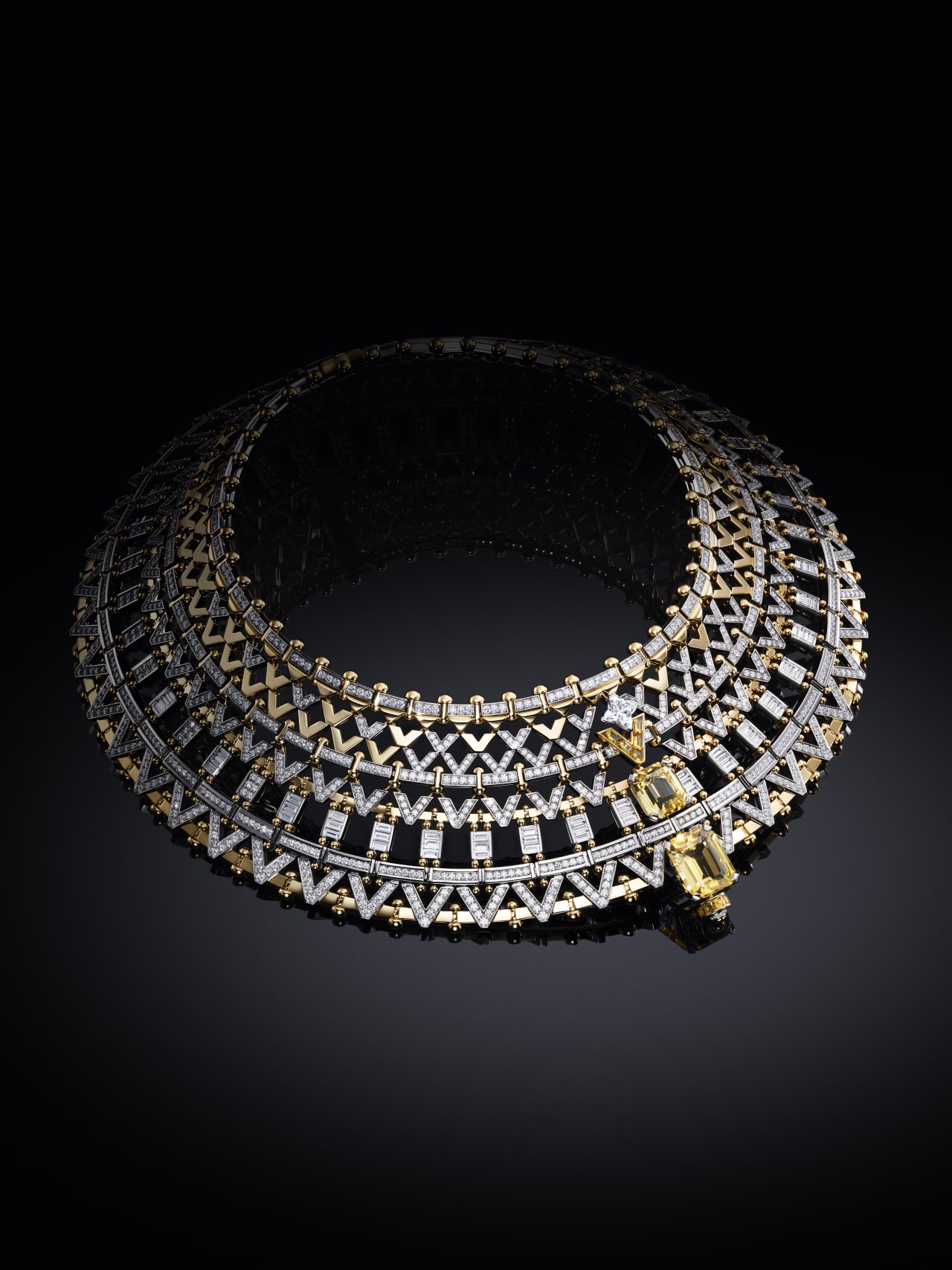Louis Vuitton Unveils Its Most Extravagant High-Jewellery Collection Ahead of Olympics
As the world turns its eyes to Paris for the start of the Summer Olympics next month, Louis Vuitton pulled out all the stops for its largest, most extravagant, and expensive high-jewellery collection with the title Awakened Hands, Awakened Minds.
Making its debut in St. Tropez on Wednesday night, the collection will encompass 13 themes and 220 pieces, some of which have yet to be unveiled. Of the 100 unique pieces that were exhibited as the first chapter, one overarching theme is clear: French pride and the celebration of the remarkably transformative period in 19th-century France, which witnessed an explosion of French influence and inventiveness.
“France in the 19th century was a phenomenal time of incredible change, and when Paris really became the centre of the world,” says Francesca Amfitheatrof, artistic director for watches and jewellery, in a news release. “The design language of Awakened Hands, Awakened Minds reflects that—all its intricacies, complications, and innovations—turned into incredible jewels.”

Courtesy of Louis Vuitton
The collection explores a journey through that century, beginning with the end of royal court rule, which resulted in a surge of creativity and talent as France’s ateliers and master craftsmen explored and experimented without limits. Among those influenced by this vibrant zeitgeist was a 16-year-old Louis Vuitton, who arrived in Paris in 1837. The apprentice developed his own unique trunkmaking métier, devising a flat and stackable trunk specifically designed for travel.
“Craftsmanship becomes the currency of this country,” Amfitheatrof said. “It is the birth of France’s Art de Vivre —and the birth of what we know as luxury today.”
The collection’s Splendeur suite took inspiration from an imperial bed embellished with low-relief woodwork in lace-like floral patterns. But the luxury brand is looking to compete for consumers with more than just aesthetics: The jewels feature more than 110 perfectly matched rubies from Mozambique, all fully traceable through blockchain technology, making Louis Vuitton the first to offer traceability of coloured stones.
Louis Vuitton’s iconic LV Monogram Flower is the chosen theme. The symbol was designed by Louis Vuitton’s son Georges in 1896 in memory of his late father. The flower is portrayed in gold and diamonds with a large centre ruby in earrings that complement a high collar, transformable necklace set with 52 rubies framed with an intricate, woven mesh of carved gold flowers. Among the collection’s most complex creations, the Splendeur necklace required the workmanship of 17 setters and 30 jewellers, who spent a total of 3,217 hours on its creation.
Louis Vuitton’s passion for travel is explored in the Vision necklace, which plays on the rivets of Louis Vuitton trunks. Crafted in platinum, yellow gold, diamonds, and yellow sapphires, the disruptive design interlaces V-shaped structures, highlighted with two octagonal-cut yellow sapphires measuring 13.47 carats and 11.79 carats. The piece occupied five jewellers, who mounted and set the necklace section by section over the course of 2,504 hours.

Courtesy of Louis Vuitton
The masterpiece of the entire collection is the Cœur de Paris, the most expensive high-jewellery piece the maison has ever produced.
The necklace pays homage to the Eiffel Tower, which was unveiled to the world at the 1899 Exposition Universelle as a beacon of modernity and ingenuity. The Cœur de Paris offers a new perspective on the structure, as if you are viewing it from underneath looking up. Pink gold rods embrace a grid of baguette settings and diamond-lit arrows, which frame the jewel’s centrepiece: a captivating 56.23-carat diamond christened the Cœur de Paris. The collection’s rarest and most important master stone radiates a unique colour with an intense pink hue complemented with unusual tones of orange and brown. It is set in a medallion that can be detached to wear as a brooch.
The centrepiece dangles from a 5.73-carat LV Monogram Star-cut diamond interlinked with 26 LV Monogram Star-cut diamonds in an opulent rivière creation that is a first for the house. A companion ring features a complementary 12.67-carat, museum-quality diamond that emanates a fancy deep, brownish pink and orange hue.
“Awakened Hands, Awakened Minds tells a story that’s very close to who we are,” Amfitheatrof said. “By showing this mixture of craftsmanship, engineering, invention, and bravery, we are really talking about Louis Vuitton. … we couldn’t celebrate in a better way.”
 Copyright 2020, Dow Jones & Company, Inc. All Rights Reserved Worldwide. LEARN MORE
Copyright 2020, Dow Jones & Company, Inc. All Rights Reserved Worldwide. LEARN MORE
A divide has opened in the tech job market between those with artificial-intelligence skills and everyone else.
A 30-metre masterpiece unveiled in Monaco brings Lamborghini’s supercar drama to the high seas, powered by 7,600 horsepower and unmistakable Italian design.
A divide has opened in the tech job market between those with artificial-intelligence skills and everyone else.
There has rarely, if ever, been so much tech talent available in the job market. Yet many tech companies say good help is hard to find.
What gives?
U.S. colleges more than doubled the number of computer-science degrees awarded from 2013 to 2022, according to federal data. Then came round after round of layoffs at Google, Meta, Amazon, and others.
The Bureau of Labor Statistics predicts businesses will employ 6% fewer computer programmers in 2034 than they did last year.
All of this should, in theory, mean there is an ample supply of eager, capable engineers ready for hire.
But in their feverish pursuit of artificial-intelligence supremacy, employers say there aren’t enough people with the most in-demand skills. The few perceived as AI savants can command multimillion-dollar pay packages. On a second tier of AI savvy, workers can rake in close to $1 million a year .
Landing a job is tough for most everyone else.
Frustrated job seekers contend businesses could expand the AI talent pipeline with a little imagination. The argument is companies should accept that relatively few people have AI-specific experience because the technology is so new. They ought to focus on identifying candidates with transferable skills and let those people learn on the job.
Often, though, companies seem to hold out for dream candidates with deep backgrounds in machine learning. Many AI-related roles go unfilled for weeks or months—or get taken off job boards only to be reposted soon after.
Playing a different game
It is difficult to define what makes an AI all-star, but I’m sorry to report that it’s probably not whatever you’re doing.
Maybe you’re learning how to work more efficiently with the aid of ChatGPT and its robotic brethren. Perhaps you’re taking one of those innumerable AI certificate courses.
You might as well be playing pickup basketball at your local YMCA in hopes of being signed by the Los Angeles Lakers. The AI minds that companies truly covet are almost as rare as professional athletes.
“We’re talking about hundreds of people in the world, at the most,” says Cristóbal Valenzuela, chief executive of Runway, which makes AI image and video tools.
He describes it like this: Picture an AI model as a machine with 1,000 dials. The goal is to train the machine to detect patterns and predict outcomes. To do this, you have to feed it reams of data and know which dials to adjust—and by how much.
The universe of people with the right touch is confined to those with uncanny intuition, genius-level smarts or the foresight (possibly luck) to go into AI many years ago, before it was all the rage.
As a venture-backed startup with about 120 employees, Runway doesn’t necessarily vie with Silicon Valley giants for the AI job market’s version of LeBron James. But when I spoke with Valenzuela recently, his company was advertising base salaries of up to $440,000 for an engineering manager and $490,000 for a director of machine learning.
A job listing like one of these might attract 2,000 applicants in a week, Valenzuela says, and there is a decent chance he won’t pick any of them. A lot of people who claim to be AI literate merely produce “workslop”—generic, low-quality material. He spends a lot of time reading academic journals and browsing GitHub portfolios, and recruiting people whose work impresses him.
In addition to an uncommon skill set, companies trying to win in the hypercompetitive AI arena are scouting for commitment bordering on fanaticism .
Daniel Park is seeking three new members for his nine-person startup. He says he will wait a year or longer if that’s what it takes to fill roles with advertised base salaries of up to $500,000.
He’s looking for “prodigies” willing to work seven days a week. Much of the team lives together in a six-bedroom house in San Francisco.
If this sounds like a lonely existence, Park’s team members may be able to solve their own problem. His company, Pickle, aims to develop personalised AI companions akin to Tony Stark’s Jarvis in “Iron Man.”
Overlooked
James Strawn wasn’t an AI early adopter, and the father of two teenagers doesn’t want to sacrifice his personal life for a job. He is beginning to wonder whether there is still a place for people like him in the tech sector.
He was laid off over the summer after 25 years at Adobe , where he was a senior software quality-assurance engineer. Strawn, 55, started as a contractor and recalls his hiring as a leap of faith by the company.
He had been an artist and graphic designer. The managers who interviewed him figured he could use that background to help make Illustrator and other Adobe software more user-friendly.
Looking for work now, he doesn’t see the same willingness by companies to take a chance on someone whose résumé isn’t a perfect match to the job description. He’s had one interview since his layoff.
“I always thought my years of experience at a high-profile company would at least be enough to get me interviews where I could explain how I could contribute,” says Strawn, who is taking foundational AI courses. “It’s just not like that.”
The trouble for people starting out in AI—whether recent grads or job switchers like Strawn—is that companies see them as a dime a dozen.
“There’s this AI arms race, and the fact of the matter is entry-level people aren’t going to help you win it,” says Matt Massucci, CEO of the tech recruiting firm Hirewell. “There’s this concept of the 10x engineer—the one engineer who can do the work of 10. That’s what companies are really leaning into and paying for.”
He adds that companies can automate some low-level engineering tasks, which frees up more money to throw at high-end talent.
It’s a dynamic that creates a few handsomely paid haves and a lot more have-nots.
From mud baths to herbal massages, Fiji’s heat rituals turned one winter escape into a soul-deep reset.
An opulent Ryde home, packed with cinema, pool, sauna and more, is hitting the auction block with a $1 reserve.






















